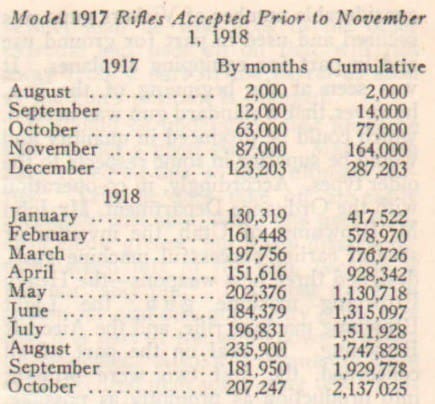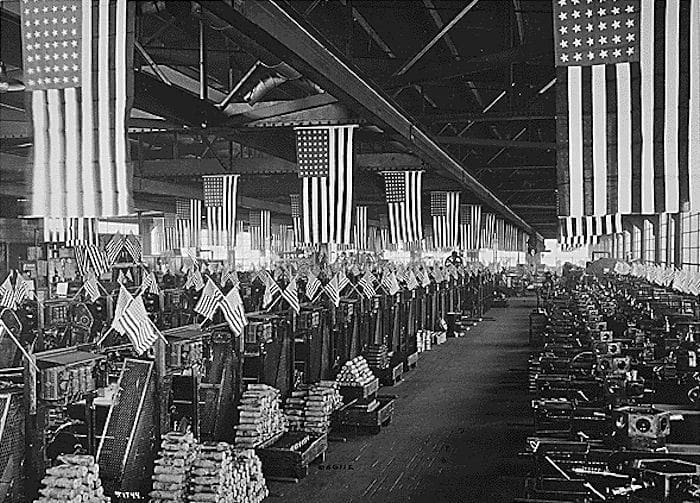When the United States entered World War I in 1917, we were woefully under-prepared (read, under-armed) for what was to come. Spurred on by the need to do their part at home to support the troops overseas, wartime production ramped up exponentially in a short period of time.
Newton Baker was the Secretary of War, and his report for 1918 details just how busy our factories were when it came to churning out arms and ammunition. (Interesting side note: Baker personally selected Gen. John J. Pershing to head the AEF.)
Here are some of the official monthly production figures for M1917 rifles:
- August 1917: 2,000 rifles
- September 1917: 12,000 rifles
- August 1918: 235,900 rifles (11,700% increase in 1 year!)
By the end of the war in November 1918, the United States had produced 2,137,025 Model 1917 rifles. But rifles were only one aspect of production. After all, what good are rifles without ammunition?

In September 1917, monthly production of rifle ammo sat at 12,000,000 rounds, or 400,000 per day. By October 1918, that figure was up to 254,000,000 rounds, or 8.46 million per day. It’s amazing to think that the daily production of rifle ammo reached a level that would have taken three weeks to produce just one year prior.
Pistol ammo was up, too: October 1918 daily output was equivalent to 5.5 days of daily output just a year before.

By war’s end, the United States’ manufacturing capabilities had been put to the test. And we passed with flying colors. It was a good, thing, too, because they would be needed again in a couple decades to again provide the Arsenal of Democracy. As it turns out, WWI wasn’t “The War to End All Wars” after all.
Logan Metesh is a firearms historian and consultant who runs High Caliber History LLC. Click here for a free 3-page download with tips about caring for your antique and collectible firearms.




Perhaps the gov should have kept the US out of it instead of progressive Wilson lying to get into war and dealing with unintended consequences of meddling. Amazing how history repeats (or at least rhymes) and we keep dealing with the fallout.
Would certainly have a different world today. The Germans had the Frogs/Brits wupped (or they had self-destructed) before we arrived on the scene and won the war for them.
Howitzer/round and MG production is far more relevant that rifle. The rifle/bayonet and field gun were already obsolete in 1914 though the French/Brits didn’t figure this out for years.
Probably wouldn’t be that different a world. German post-war aims didn’t include the erasure of France and England from the map. Germany would have taken a bit of France and turned it into a German puppet state and made Prussia a bit bigger at Russia’s expense, but wouldn’t have done much beyond that.
Wouldn’t have mattered much in the longer run anyway, given that the societal and political forces set loose by the war would have resulted in another war in 20 years or so.
Britain’s national debt grew from £650 million in 1914 to £7.4 billion in 1919 (when a billion was a lot of money), and most of it was owed to US interests. Had England lost WW1, that all debt would have been an immediate write-off. On top of that, Britain was our major trading partner.
Wilson was persuaded that the US economy couldn’t take it if Britain lost the war. IDK, but he might have been right.
Eh. It’s popukar online these days to dish out these lines, but there’s actually a lot more to WW1 than what’s ussually posted. The US had every justification to enter the war. I’m not going to go on and write a book about it here. But you are certainly correct about Wilson. Woodrow Wilson was one of, if not the, worst presidents this nation ever had.
The naval blockade starved the germans out of the war. America’s largest contribution to the war effort was food and man power. The brits and french were fed regularly and a fresh infusion of men was just what they needed.
America was still equipped with a frontier army at the start of the war. Not enough men or kit to do much for the first 6 months of our war effort. American pilots flew british and french aircraft because we had no aircraft suitable for combat. Most of our artillery was also provided by the euros.
If memory serves the US navy managed to sink 1 u-boat. 1. For the entirety of our war effort.
The germans were tired and hungry after 4 years of war. Facing the possibility of millions of fresh troops proved to be to much for them.
Must read book….Freedoms Forge by Arthur Herman. Remarkable story of the key folks who built our war machine. Especially Bill Knudsen out of the auto industry.
https://www.amazon.com/Freedoms-Forge-American-Business-Produced/dp/0812982045
Indeed.
As is being seen at Tesla, the ability to create mass production of quality goods is a feat all of its own. Elon Musk does not have that talent, and apparently, neither does anyone who works for him.
DG, I get that you don’t care for Musk.
I ask that you give this a fair read, it lays out just who is ripping off the US government in ongoing launch contracts :
https://arstechnica.com/science/2018/02/three-years-of-sls-development-could-buy-86-falcon-heavy-launches/
Most egregious is the billion a year that one company gets, just to keep the factory lights on. No rockets, just the lights on…
“Must read book….Freedoms Forge by Arthur Herman.”
Seconded, great read…
Also, in June 1918 the huge German offensive thrust was stopped by fresh American troops at Chateau-Thierry and Belleau Wood, just 75 miles from Paris. That’s as far as the German Army got and after that it was all retrograde movement for them until November 1918. The Brits and French were as tired as the Germans were, and I believe it was the vigor and (despite borrowed weapons and equipment) fighting spirit of American troops that helped drive the Germans back and give that necessary added spark to our allies.
Well that’s all well and good BUT without the defeat of the Central Power’s there would be no British Mandate. No partition of Palestine. No Israel. No return of JESUS…WWI had to happen. Yeah I think America became a world power in defeating a non-enemy. Kinda’ like our idiotic war on terror against Iraq. It made Iran unopposed except for Israel’s nuclear arsenal…oh and Hitler will never be “rehabilitated”. Germany deserved what they got.
“without the defeat of the Central Power’s there would be no British Mandate. No partition of Palestine. No Israel. No return of JESUS…”
. . . and no WW2.
The P1917 is a solid rifle. Heavy as hell, built like a brick outhouse.
The choice of gunsmiths and custom gunmakers for making hell-for-stout dangerous game rifles for years and years.
I have three of them. One original. One of the strongest actions ever built.
Dont think we could do the same things today. We could fight, but not produce. And Government red tape wouldnt help us.
“Dont think we could do the same things today.”
It would be difficult, a lot of that massive tooling was scrapped after the war and likely ended up in Chevy engine blocks…
there was an editorial somewhere on the internet the other day (not on cnn or drudge or anything, a bit more obscure website) about military spending and how overhyped russia is as a military power. it made an interesting point about logistics and spending. the article claimed that with the use of munitions, explosives, supplies etc. in afghanistan and elsewhere the past 20 years plus the states not being in wartime production mode, if the us and russia got into a non-nuclear war, both sides would run out of essential supplies within a few days. not sure exactly how true that is, but its food for thought.
Weight aside, anyone that’s fired an M1917 or a P14 knows it’s a much better rifle than any Mauser or Enfield action. Combines the best of the Mauser action with the best of the Enfield action. Shame the US likes to ignore that great rifle in place of the Mauser ripoff.
Right? With all of the P17s shown here to have been in stock, why did we issue the 03 in WW2? What happened to the rifles, and why didn’t MacArthur have at least a few thousand of them in the Philippines?
What happened was lend lease and Bubba. The majority of the surplus rifles were sporterized or given to other countries. It’s kind of sad, really. The rifle had tons of potential and would have made a lot of sense as a sniper rifle in WW2 due to its heavy barrel.
Comments are closed.